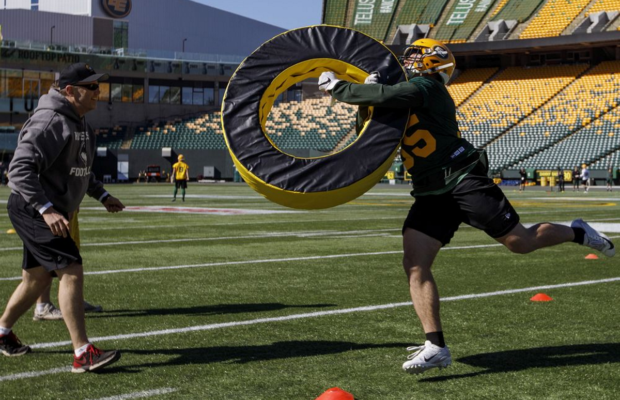OPINION: The CFL launched its 2.0 initiative this off-season with its first draft of international players. As for Randy Ambrosie’s global ambitions, it would be unfair to judge its success on its first year but, to date, the results haven’t exactly changed the existing world order.
On the first DreamChasers tour, Brandon Collier packed 13 of Europe’s top young football players into a bus, then made stops at five Division I schools and a handful of other scouting combines.
The bus was driven by one of the recruit’s father. Let’s be diplomatic here and say they were regarded as a curiosity in the football world.
That was three years ago. This spring, Collier took 43 players with him to audition for 12 university programs including Alabama and Clemson. He’s also helped send players like Germany’s Julius Weischoff, a 6-6, 250-pound former mogul skier turned defensive end, to Michigan; Germany’s Alex Ehrensberger, a 6-7 240-pound defensive end, to Notre Dame and Sweden’s Viktor Wikstrom, a 6-3, 225-pound tight end with 4.5 speed to West Virginia.
Penn State, meanwhile, sent its coaching staff to Germany this spring where they signed Joseph Darkwa, a 6-5, 270-pound defensive lineman. And TCU has landed Alexander Honig, a 6-5, 230-pound quarterback with a 38-inch vertical.
It was Honig’s father James who drove the bus on the first tour.
“By the end of this year, early next year you’ll know about these guys,” Collier says. “The next three to five years the NFL and CFL will be loaded with international talent. It will be normal to see these kids. It’s only a matter of time before the floodgates really open.”
Collier, the former Winnipeg Blue Bomber defensive lineman, is speaking this day from Frankfurt where he’s assumed a lead role in a compelling and rapidly developing football story. His company, Prime Players International, is helping to reshape the world of recruiting by identifying and delivering a new generation of Euros to the NCAA.
There are currently some 30 European-born players at American colleges and in three to four years those players will begin to make their way into the pro ranks. The very best hope to find work in the NFL but, for our purposes, the more interesting prospect concerns Canada where CFL commissioner Randy Ambrosie’s stated goal is to make his league, “the pre-eminent global football league in the world.”
“We’re going to build bridges to the rest of the world and celebrate all these amazing players from around the world,” Ambrosie said at the Lions-Redblacks’ game on Sept. 13 at B.C. Place Stadium.
“I think we’re going to have an active relationship with a dozen countries. We’re going to have seven to 10 broadcast deals. It’s going to change us from a relatively humble existence to one I think we’re worthy of, a league on the global stage.”
Ambrosie said he believes this will happen in the next five years. You have to admit, that’s a tight timeline to conquer the world.
The CFL, of course, launched its 2.0 initiative this off-season with its first draft of international players. As for Ambrosie’s global ambitions, it would be unfair to judge its success on its first year but, to date, the results haven’t exactly changed the existing world order.
The best player to emerge from the global pool is Winnipeg’s Thiadric Hansen, a 26-year-old linebacker/defensive end who’s dressed for every Bombers’ game this season. Hansen started the year on special teams but has made his way into the defensive line rotation. Last year, he was driving a school bus in Germany.
Edmonton’s Maxime Rouyer, a linebacker from France, has also seen regular duty on special teams but beyond those two players, it gets lean.
The Lions have three international players on their roster: receivers Gerardo Alvarez and Fernando Richarte from Mexico, and Benjamin Plu from France. Alvarez dressed for the Lions first six games before suffering a knee injury. Richarte has dressed for the last six. Neither has played a snap but Lions’ GM Ed Hervey said the league is playing the long game with these athletes.
“We’re always looking for players,” said Hervey. “If you can expand your pool, you can expand the interest. Enrolment has gone down at the amateur level in North America. If football is going to survive, we have to expand.”
Which is where Collier comes in. After bouncing around the NFL and CFL, he moved to Germany in 2013 and saw an opportunity. There are some 300 club teams in Germany. Simple math tells you that, in a country of 83 million, there were going to be some athletes on those teams. It’s a similar story in France, Austria, Sweden and the U.K.
“When I first started, I was recruiting the schools, they weren’t recruiting our kids,” Collier said. “Now I have coaches calling all the time. I think in two to four years, some of these kids will be at the same level as the top Canadians and some Americans.”
So how does the CFL mine this rich vein of talent?
That’s an interesting question. Collier has encountered some resistance at the federation level of the countries he recruits. Those federations point out he’s taking the best players from their domestic leagues and offering few, if any guarantees of playing time in the United States.
It’s similar to the resistance the NHL encountered when it first started signing players from Sweden and Finland in the 1970s and ’80s. The CFL, as it happens, has agreements with 10 countries, including eight in Europe.
Collier was asked about his relationship with the CFL.
“There’s nothing official but it would be a dream to work with the CFL,” he said.
The league office, for its part, wrote in an email that it is familiar with Collier and plans to meet with him soon.
They shouldn’t delay. The world, after all, is waiting.
